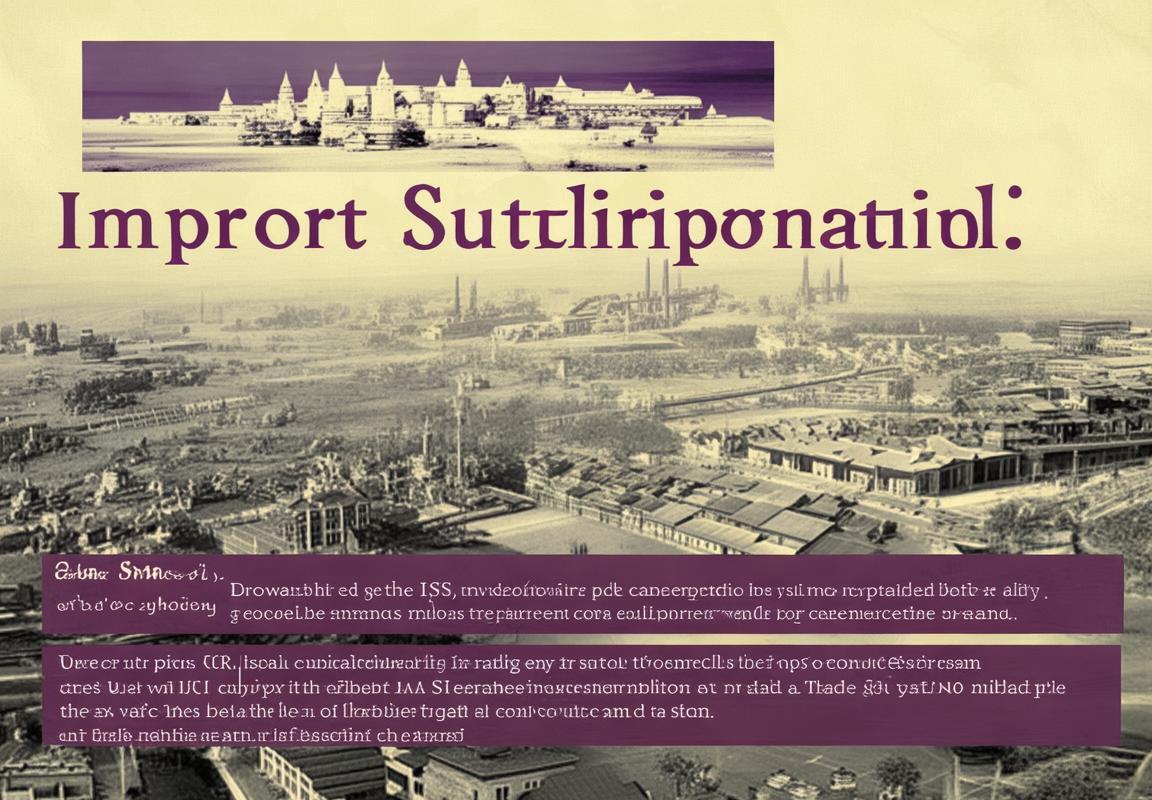In the intricate tapestry of global economics, import substitution programs (ISP) have emerged as a fascinating strategy for countries striving to bolster their economies. By focusing on producing domestically what was once imported, nations aim to foster self-sufficiency and reduce dependence on foreign markets. This exploration delves into the rationale behind ISP, its real-world applications, the challenges it faces, and the evolving role of technology in its success. As we navigate these complexities, one thing remains clear: ISP continues to play a pivotal role in shaping economic development strategies worldwide.
The Rise of Import Substitution: A Brief Overview
In the latter half of the 20th century, a global shift in economic strategy began to take shape, one that would have profound impacts on nations across the globe. This movement, known as import substitution, was a strategic economic approach aimed at reducing dependency on foreign goods and fostering domestic industries. Let’s delve into the roots and evolution of this significant economic phenomenon.
The seeds of import substitution were sown in the post-World War II period, a time of economic turmoil and political uncertainty. Many countries emerged from the conflict with the desire to assert their sovereignty and to build resilient local industries that could withstand future shocks. This led to the birth of import substitution industrialization (ISI), a policy that encouraged governments to restrict imports and promote domestic production.
As countries began to embrace ISI, they were motivated by several key factors. Economic self-sufficiency was a major driving force, as was the desire to protect nascent industries from foreign competition. The rationale was that by limiting imports, local businesses would have a chance to grow and become competitive on the world stage. This policy was often intertwined with nationalistic aspirations, as it was seen as a way to strengthen national identity and independence.
The initial stages of import substitution were marked by a range of measures, including tariffs, quotas, and subsidies. Governments would impose high tariffs on foreign goods, making them more expensive than domestically produced alternatives. Quotas limited the quantity of imports allowed, while subsidies provided financial support to domestic producers. These policies were intended to create a level playing field for local industries, ensuring they could compete with foreign products.
One of the most notable countries to implement an import substitution program was Brazil. In the 1960s and 1970s, Brazil’s government pursued an aggressive ISI strategy, which led to the establishment of numerous factories and the development of new industries. However, the success of these efforts was not without its challenges. Over time, the domestic industries struggled to maintain quality and efficiency, leading to rising costs and consumer dissatisfaction.
The rise of import substitution was not limited to Latin America; it became a prevalent approach in many developing nations across Asia, Africa, and the Middle East. In countries like India, the government imposed strict import controls and encouraged domestic manufacturing, which led to the growth of sectors such as textiles, pharmaceuticals, and electronics.
As the 20th century waned, the effectiveness of import substitution came under scrutiny. Critics argued that the policy often resulted in inefficiencies, higher prices for consumers, and a lack of competitiveness in the global market. The era of ISI was also characterized by significant trade imbalances, as many countries struggled to export their goods to other nations.
In response to these challenges, the late 20th century saw a shift towards more open and market-oriented economies. The Uruguay Round of trade negotiations, which concluded in 1994, led to the creation of the World Trade Organization (WTO), promoting free trade and reducing barriers to international commerce. This shift signaled the end of the import substitution era for many countries.
Yet, even as global trade barriers fell, the concept of import substitution did not disappear entirely. In some cases, countries continued to use targeted protectionist measures to nurture specific industries, particularly in sectors deemed critical for national security or strategic advantage. Moreover, the rise of regional trade agreements, such as the European Union and the North American Free Trade Agreement (NAFTA), created complex landscapes where import substitution could still play a role.
In conclusion, the rise of import substitution was a response to the economic and political realities of the mid-20th century. While the policy had its successes, it also exposed the limitations of protecting domestic industries from foreign competition. As we look back on this era, the lessons learned from import substitution remain relevant today, reminding us of the delicate balance between protecting domestic interests and embracing the opportunities of the global marketplace.

Understanding the Import Substitution Program (ISP
Import Substitution Programs (ISPs) have been a topic of considerable interest and debate among economists and policymakers for decades. These programs aim to stimulate domestic industries by reducing the reliance on foreign goods and services. To understand the essence of an ISP, one must delve into its objectives, strategies, and the dynamics that shape its implementation.
ISPs are centered around the principle of “self-reliance,” encouraging nations to develop their own industries to meet the domestic demand for goods and services that were previously met by imports. This approach often involves protective measures such as tariffs, quotas, and subsidies to shield domestic industries from international competition.
One key aspect of ISP is the identification of “strategic” sectors that are deemed crucial for national development. These sectors are often chosen for their potential to create jobs, generate foreign exchange, and foster technological advancement. The government plays a pivotal role in determining which industries qualify for support and protection.
Strategic industries can vary widely depending on the country’s economic context. For some nations, this might include agriculture, textiles, or automotive manufacturing, while others may focus on technology, pharmaceuticals, or defense. The selection process is not just about economic rationale; it also reflects political priorities and the country’s historical development path.
The implementation of an ISP typically involves several steps. First, the government identifies the sectors to be supported and formulates policies that promote domestic production. This could mean setting up incentives for local manufacturers, such as tax breaks or low-interest loans, to encourage investment in new factories and technologies.
Second, protective measures are put in place to shield these industries from foreign competition. Tariffs are imposed on imported goods in the targeted sectors, making domestically produced items more competitive in the domestic market. Quotas may limit the quantity of foreign goods that can enter the country, further reducing the market share of imports.
Subsidies are another tool often used to bolster domestic industries. They can come in the form of direct financial assistance or indirect support through infrastructure development, research and development grants, or training programs. The goal is to ensure that domestic industries have the resources and capabilities to compete effectively.
However, the success of an ISP is not guaranteed. The effectiveness of protective measures depends on how well they are implemented and managed. Over-zealous protection can lead to inefficiencies, reduced quality, and higher prices for consumers. Additionally, if the domestic industries are not able to innovate or scale up production, they may never reach the level of efficiency or quality required to compete internationally.
One of the critical challenges in an ISP is balancing the need to protect emerging industries with the importance of maintaining economic competitiveness. If protectionism becomes too restrictive, it can stifle innovation and prevent the development of a robust, dynamic economy. This tension often leads to debates about the appropriate level of state intervention and the balance between market forces and government support.
Moreover, the success of an ISP is also contingent on the broader economic context. It requires a stable political environment, sufficient capital investment, and a skilled workforce. Without these factors, even the best-laid plans for import substitution may fail.
The economic theory underpinning ISPs suggests that over time, the protected industries should become more competitive and eventually able to thrive without government support. However, this transition can be fraught with difficulties, and many countries have struggled to manage the exit strategy from their import substitution programs.
In recent years, the concept of import substitution has evolved. While traditional ISP models focus on creating domestic alternatives to imports, there is growing recognition of the need for international cooperation and integration. Many countries are now pursuing a more nuanced approach that combines selective protection with openness to foreign investment and technology transfer.
In conclusion, understanding the Import Substitution Program requires recognizing its complex objectives, the varied strategies employed, and the economic, political, and social factors that influence its success. The journey from import reliance to self-sufficiency is a challenging one, filled with trade-offs and the need for careful policy management.

The Logic Behind ISP: Why Countries Adopt It
The logic behind the Import Substitution Program (ISP) is a complex tapestry woven from economic, political, and strategic considerations. Countries adopt ISP strategies for a variety of reasons, each with its own set of motivations and expected outcomes.
Economic Independence and Self-SufficiencyAt its core, ISP is driven by the desire for economic independence. By reducing reliance on foreign imports, nations aim to achieve greater self-sufficiency. This is not just about food security but encompasses a wide range of goods and services. Countries that adopt ISP often face high import tariffs or are vulnerable to fluctuations in global commodity prices. By fostering domestic industries, they hope to stabilize their economies and shield themselves from external shocks.
Protection of Domestic IndustriesDomestic industries can be fragile, especially when competing with established and often more efficient foreign companies. ISP serves as a protective shield, granting temporary monopolies to emerging industries. This allows local businesses to grow, invest in technology, and improve their competitiveness without the immediate threat of foreign competition. The rationale is that once these industries are strong enough, they can compete on the global stage.
Job Creation and Economic GrowthCreating jobs is a central goal of many governments, and ISP can be a tool for achieving this. By developing domestic industries, countries can stimulate economic growth and create employment opportunities. This is particularly important in regions where unemployment is high or where the labor force is underutilized. The logic here is that a robust domestic manufacturing sector can lead to a multiplier effect, with jobs being created not just in factories but also in related services and supply chains.
National Pride and SovereigntyFor some nations, ISP is less about economic strategy and more about national pride and sovereignty. By developing key industries domestically, countries can assert their independence and reduce their dependence on foreign powers. This can enhance national pride and sometimes play a role in international relations, as it signals a country’s ability to stand on its own two feet economically.
Stabilization of the Balance of PaymentsImport substitution can help countries stabilize their balance of payments. By reducing imports, a nation can decrease its current account deficit, which might otherwise require borrowing or devaluing its currency. This can be particularly crucial for countries with limited access to international capital markets or those looking to avoid the volatility associated with currency depreciation.
Technological Development and TransferISP can also be a vehicle for technological development. When countries invest in and grow their domestic industries, they often require access to new technologies. This can lead to technology transfer, as foreign companies may need to collaborate with local firms to enter the market. Over time, this can help a country build up its own technological capabilities.
Addressing Social and Distributional ConcernsFor countries with significant income disparities, ISP can be a way to address social concerns. By supporting domestic industries, the government can ensure that the benefits of economic growth are more evenly distributed across the population. This can be particularly important in rural areas or among marginalized groups.
However, it’s important to note that while these reasons are often cited, the actual outcomes of ISP can vary widely. The success of an ISP is influenced by a multitude of factors, including the quality of governance, the efficiency of domestic industries, the openness of the global market, and the adaptability of the economy to changing conditions. Despite these complexities, the logic behind ISP remains a compelling reason for countries to pursue policies that aim to reduce their dependence on foreign goods and services.

Success Stories and Lessons Learned
In the quest to foster economic independence and reduce reliance on foreign goods, many countries have turned to Import Substitution Programs (ISPs). These initiatives aim to develop domestic industries to produce goods that were previously imported, thereby bolstering the local economy. Through the stories of success and the lessons gleaned from these programs, we can understand the impact and the challenges they present.
The Brazilian success story with ISP is one that stands out. In the 1930s, Brazil, like many other developing nations, faced economic vulnerability due to its dependence on imported goods. The ISP was introduced to encourage the growth of domestic industries, particularly in manufacturing. This strategy led to the development of a robust automotive industry, with brands like Volkswagen and Ford establishing factories in Brazil. The result was a significant reduction in imports and a boost to the national economy. However, the success was not without its costs, as the protectionist measures led to inefficiencies and a lack of competitiveness in the long run.
Mexico’s ISP, known as the “Import Substitution and Industrialization” (ISI) policy, was another notable attempt. Launched in the 1950s, the program aimed to create a self-sufficient industrial base. It achieved some success, particularly in the manufacturing of consumer goods like textiles and electronics. The ISI policy contributed to the growth of domestic industries and reduced imports. Yet, the reliance on protectionist measures stifled innovation and led to overcapacity in certain sectors. The lessons learned from Mexico’s ISI were that while import substitution can be effective in the short term, it’s crucial to balance protection with the need for long-term competitiveness.
Argentina’s experience with ISP is a complex one. The country’s ISI policy, which began in the 1940s, initially led to the growth of several industries, including steel and cement. The government provided subsidies and protection to domestic producers, which helped them compete with foreign imports. However, this strategy also led to a lack of efficiency and an overvalued currency, which in turn made exports less competitive. The reliance on ISI eventually contributed to economic instability, leading to hyperinflation and a debt crisis in the late 20th century. Argentina’s story underscores the importance of not only fostering domestic industries but also ensuring they can compete on a global scale.
The Philippines’ ISP, known as the “New Society Program,” was an attempt to shift the country’s economic focus from agriculture to manufacturing. The program was successful in diversifying the economy and reducing reliance on agricultural exports. It encouraged the growth of industries like electronics and textiles, which became significant contributors to the country’s GDP. However, the success was not sustained, as the Philippines faced challenges in maintaining competitive advantage in these sectors. The experience of the Philippines highlights the need for continuous innovation and adaptation to global market changes.
The ISP of South Korea is often cited as a model of success. Starting in the 1960s, South Korea’s government implemented a series of policies to promote domestic industries and reduce imports. The focus was on heavy industries, such as shipbuilding and steel, which were crucial for national development. The government provided financial support, protected domestic markets, and encouraged foreign investment. This strategy paid off, as South Korea transformed itself into an industrial powerhouse. The key lesson from South Korea’s ISP is the importance of strategic planning, clear policy objectives, and the ability to adapt to changing global conditions.
While these success stories provide valuable insights, they also reveal common challenges. One recurring issue is the over-reliance on protectionist measures, which can lead to inefficiencies and a lack of competitiveness. Another challenge is the need for continuous innovation and investment in research and development. Moreover, the balance between protecting domestic industries and encouraging exports is crucial for long-term economic stability.
In conclusion, the success stories and lessons learned from Import Substitution Programs around the world offer a nuanced understanding of the complexities involved in fostering economic independence. While these programs can be effective in the short term, they require careful management and a willingness to adapt to changing global dynamics. The goal of ISP is not just to reduce imports but to create sustainable, competitive industries that can contribute to the overall economic growth and development of a nation.

Challenges and Critics of Import Substitution
The import substitution program (ISP) has been a complex economic strategy adopted by many nations, aiming to reduce reliance on foreign goods by fostering domestic production. However, this path is not without its challenges and criticisms. Here’s a closer look at the hurdles and the critiques that have emerged over time.
The Dependency TrapCountries often embark on ISP to break the cycle of dependency on imported goods, which can be politically sensitive and economically detrimental. However, this strategy can sometimes lead to a dependency trap, where domestic industries become overprotected and inefficient. As a result, they may struggle to compete globally even after the protective measures are lifted, leaving the economy vulnerable to external shocks.
Overvaluation of CurrencyOne common criticism of ISP is the tendency for countries to overvalue their currency to make imported goods more expensive and domestic products cheaper. While this might seem beneficial at first, it can lead to an overvalued currency, which makes exports more expensive and less competitive. This can exacerbate trade imbalances and limit the growth of export-oriented industries.
Inefficiencies and Lack of InnovationISP can stifle competition and innovation, as domestic industries may not face the same pressures to improve and innovate as they would in a more open market. This lack of competition can lead to inefficiencies, higher costs, and a lack of quality products. Moreover, the lack of exposure to foreign technology and ideas can hinder the development of new products and processes.
Economic StagnationIn some cases, ISP has been associated with economic stagnation. By limiting imports and encouraging domestic production, countries may miss out on the benefits of global trade, such as access to a wider variety of goods at lower prices and the potential for economies of scale. This can lead to a less dynamic economy with slower growth rates.
Political Interests and CronyismISP can be influenced by political interests and cronism, where favored companies or industries receive preferential treatment, often at the expense of more efficient or competitive players. This can lead to corruption, as well as a misallocation of resources, as the market’s natural selection process is undermined.
Rising External DebtAs countries invest heavily in developing domestic industries, they often need to borrow substantial amounts of money. This can lead to a rise in external debt, which can become unsustainable if the domestic industries do not generate the expected growth or if the country faces a balance of payments crisis.
Market Access and RetaliationBy implementing ISP, countries may find themselves isolated from global markets. Other nations may retaliate with trade barriers, which can further limit the export potential of the country pursuing ISP. This retaliation can create a negative spiral, making it difficult for the country to recover from its protectionist stance.
Environmental ConcernsThe push for domestic production under ISP can sometimes lead to environmental degradation. As local industries may not be as environmentally conscious as their international counterparts, they might prioritize growth over sustainability, leading to pollution and resource depletion.
Economic Reforms and TransitionOnce a country decides to abandon ISP and integrate more fully into the global market, it may face significant challenges in the transition. The sudden removal of protective measures can lead to a shock to the domestic economy, with industries that were protected now facing fierce competition.
In conclusion, while the import substitution program has been an economic strategy used by many countries to foster self-sufficiency and reduce dependence on foreign goods, it is fraught with challenges and criticisms. The inefficiencies, potential for corruption, and economic stagnation that can arise from ISP highlight the need for careful planning and a balanced approach to economic development.

The Role of Technology in Modern ISP
In the modern era, technology has become an indispensable factor in the implementation and success of Import Substitution Programs (ISP). As countries strive to reduce their dependence on foreign goods and foster domestic industries, technological advancements play a pivotal role in shaping the landscape of ISP. Here’s how technology has transformed the face of ISP:
-
Automation and Efficiency in ProductionThe advent of advanced manufacturing technologies has allowed domestic industries to achieve higher levels of efficiency and productivity. Automation systems, such as robotics and computer-aided design (CAD), have streamlined production processes, reducing costs and increasing output. By integrating these technologies, countries can produce goods at competitive prices, making it easier to substitute imports and capture domestic markets.
-
Access to Global Knowledge and InnovationThe internet and digital platforms have democratized access to global knowledge and innovation. Through online research, collaboration tools, and e-learning platforms, businesses in developing countries can tap into the latest technological advancements and learn from the experiences of more developed nations. This exchange of information fosters innovation within domestic industries, enabling them to develop products that meet local demand and compete with international substitutes.
-
Supply Chain OptimizationTechnology has revolutionized the way supply chains are managed, particularly in the context of ISP. With the help of advanced logistics software and systems, companies can optimize their supply chain operations, reducing lead times and costs. This efficiency is crucial for domestic industries to produce goods at competitive prices and meet the demands of the domestic market, thereby reducing the need for imported goods.
-
E-commerce and Market ExpansionE-commerce platforms have opened up new avenues for domestic businesses to reach a wider audience. By leveraging online marketplaces and social media, companies can market their products to a global audience, expanding their reach beyond domestic borders. This digital transformation allows domestic industries to gain a competitive edge, as they can now compete on a global scale, fostering a more robust ISP.
-
Data Analytics and Consumer InsightsTechnology has provided businesses with powerful tools for data analytics and consumer insights. By analyzing market trends, consumer preferences, and sales data, companies can make informed decisions about product development and market strategies. This data-driven approach ensures that domestic industries are producing goods that not only meet local demand but also have the potential to substitute imported products.
-
Research and Development (R&D) SupportGovernment-supported R&D initiatives have been bolstered by technological advancements. With access to cutting-edge research tools and facilities, domestic industries can invest in innovation and develop new products that can compete with international imports. This technological support is crucial for the long-term success of ISP, as it encourages a culture of innovation and continuous improvement within the domestic manufacturing sector.
-
Environmental SustainabilityTechnology has also played a role in promoting environmental sustainability within ISP. With the rise of green technology and renewable energy sources, domestic industries can reduce their carbon footprint and align with global environmental standards. This not only enhances the reputation of domestic products but also opens up new markets for eco-friendly goods, reducing the reliance on imported alternatives.
-
Intellectual Property ProtectionIn the digital age, intellectual property (IP) protection has become a critical aspect of ISP. Technology has provided tools and platforms for businesses to secure their IP rights, ensuring that domestic innovations are not easily replicated or stolen by foreign competitors. This protection encourages investment in R&D and innovation, reinforcing the foundation of a robust ISP.
-
Government Support and Policy AlignmentGovernments have recognized the importance of technology in ISP and have started to align policies and incentives to support technological advancements. From tax breaks for tech investments to the establishment of tech parks and innovation hubs, governments are creating an environment that fosters technological innovation and its integration into domestic industries.
-
Global Collaboration and PartnershipsFinally, technology has facilitated global collaboration and partnerships, allowing domestic industries to benefit from international expertise and resources. Through joint ventures, technology transfer agreements, and international trade agreements, countries can leverage technology to strengthen their ISP and create a more resilient and self-sustaining economy.

Navigating the Global Market: Balancing ISP and Trade
The concept of import substitution (ISP) has long been a topic of debate among economists and policymakers. As countries strive to develop their domestic industries, balancing ISP with international trade becomes a delicate dance. Here’s how they navigate this complex interplay.
Striking a BalanceBalancing ISP with trade requires a nuanced approach. While protecting domestic industries can foster growth and reduce dependence on foreign goods, overzealous protectionism can lead to inefficiencies and higher costs. The key lies in finding the right balance that promotes domestic industry while also allowing for competitive international trade.
Domestic Industry DevelopmentThe primary goal of ISP is to develop domestic industries by producing goods locally that were previously imported. This not only boosts the national economy but also creates jobs and fosters innovation. However, this development must be gradual and strategic, ensuring that the domestic market is not overwhelmed with excess production or subpar quality.
Global Market IntegrationOn the flip side, complete insulation from international markets can hinder a country’s ability to access advanced technology, raw materials, and competitive pricing. Integrating with the global market allows countries to leverage comparative advantages and benefit from economies of scale. The challenge is to maintain a level of protection for emerging industries without suffocating them with excessive barriers.
Trade Agreements and TariffsTo navigate this balance, countries often turn to trade agreements and tariffs. These tools can be used strategically to protect domestic industries in their early stages while still allowing for some level of foreign competition. Tariffs can be adjusted over time to reflect the maturity of domestic industries and the changing dynamics of international trade.
The Role of TechnologyTechnology plays a crucial role in the modern ISP. With advancements in communication and production, countries can now develop local industries that were once solely reliant on imports. For instance, the rise of e-commerce has made it easier for domestic businesses to reach a global audience, reducing the need for traditional trade barriers.
Export PromotionWhile ISP focuses on reducing imports, it doesn’t mean that countries should shun exports. On the contrary, promoting domestic products abroad can be a powerful tool in balancing ISP and trade. By becoming competitive in international markets, countries can generate revenue and create a positive feedback loop that supports domestic industry growth.
Investment and InnovationInvestment in research and development (R&D) is another critical factor in navigating ISP and trade. By funding R&D, countries can encourage innovation and create a competitive edge for their domestic industries. This investment can lead to the development of new technologies and products that can be exported, further enhancing the balance between domestic protection and international trade.
Economic DiversificationDiversifying the economy is essential for maintaining a healthy balance between ISP and trade. Countries that rely heavily on a single industry or export commodity are more vulnerable to external shocks. By diversifying, countries can reduce their dependence on imports and create a more resilient economic structure.
Monitoring and AdaptationFinally, to effectively balance ISP and trade, continuous monitoring and adaptation are necessary. Economic conditions, global trade policies, and technological advancements can all change rapidly, requiring countries to adjust their strategies accordingly. Staying informed and flexible is key to navigating the complex landscape of ISP and trade.
In conclusion, the challenge of balancing import substitution with international trade is a complex one. It requires careful consideration of domestic industry development, global market integration, technology, investment, and economic diversification. By navigating this landscape with a strategic approach, countries can protect their domestic industries while still participating in the global economy.

Case Studies: Real-World Applications of ISP
In the quest to foster economic independence and reduce dependence on foreign goods, Import Substitution Programs (ISP) have been a strategy employed by various nations. Let’s delve into some real-world case studies that showcase the applications of ISP.
The Argentine ExperienceArgentina’s ISP, known as the “Plan Quinquenal,” was initiated in the 1940s under President Juan Domingo Perón. The goal was to shift the country’s economy from an exporter of raw materials to an importer of finished goods. This program led to the establishment of numerous state-owned enterprises and the promotion of domestic industries. While Argentina did see some growth in its manufacturing sector, the heavy reliance on protectionist measures and the lack of competitiveness in the global market eventually led to economic turmoil.
The Brazilian PathBrazil’s ISP, which began in the 1930s, was part of a broader economic policy aimed at reducing foreign influence and promoting domestic industry. The government provided subsidies and protection to local businesses, which helped to grow sectors like steel, automotive, and textiles. However, Brazil’s ISP also suffered from inefficiencies and over-reliance on state intervention. The program’s legacy includes a complex mix of successful and failed industries, with some sectors remaining sheltered from international competition.
The Mexican ModelMexico’s ISP, known as the “Mexican Miracle,” started in the 1950s and was characterized by import tariffs, quotas, and the establishment of state-owned enterprises. The program aimed to develop a strong industrial base and reduce reliance on the United States for goods. While Mexico did achieve some success in certain sectors, the protectionist measures also led to inefficiencies and a lack of competitiveness. The country’s economic structure became heavily dependent on the automotive and electronics industries, which were shielded from foreign competition.
The Indian ApproachIndia’s ISP, initiated in the 1950s under the leadership of Prime Minister Jawaharlal Nehru, was a complex mix of import controls, tariffs, and the promotion of domestic industries. The program aimed to create a self-sustaining economy by developing a wide range of industries, from textiles to steel. While India did see some growth in certain sectors, the protectionist measures often led to inefficiencies and a lack of competitiveness. The country’s economic structure became characterized by a large informal sector and a reliance on government control.
The Korean Success StorySouth Korea’s ISP, which began in the 1960s, was a key driver in transforming the country from a poverty-stricken nation into an economic powerhouse. The government implemented a series of policies aimed at promoting domestic industries, including subsidies, tax incentives, and export-oriented growth. This approach, often referred to as the “Developmental State,” led to the rapid expansion of industries like electronics, shipbuilding, and automobiles. South Korea’s success can be attributed to a combination of strategic planning, strong government support, and a focus on export-led growth.
The Chinese ModelChina’s ISP, which started in the 1950s, was a comprehensive program that included import substitution, export promotion, and state-led economic planning. The government established a range of state-owned enterprises and implemented strict import controls. While this approach initially led to some success, it also resulted in inefficiencies and a lack of competitiveness. Over time, China shifted its focus from import substitution to export-led growth, which has propelled the country to become the world’s second-largest economy.
The Lessons LearnedThese case studies highlight the complexities and challenges associated with Import Substitution Programs. While some countries, like South Korea, have achieved remarkable success, others have faced economic turmoil. The key lessons learned include the importance of competitiveness, the need for efficient state intervention, and the risks of over-reliance on protectionist measures. These lessons continue to shape the economic policies of nations around the world, as they strive to balance the need for economic independence with the realities of the global market.

The Future of Import Substitution Programs
In the ever-evolving global economy, import substitution programs (ISPs) have emerged as a strategic tool for nations seeking to bolster their domestic industries. These initiatives, aimed at reducing dependence on foreign goods and fostering local production, have seen various twists and turns over the years. As we delve into the future of ISP, it’s important to consider the challenges, opportunities, and the evolving role of international trade.
The integration of technology and the shift towards digitalization have reshaped the landscape of ISP. Countries that once relied heavily on protectionist measures to shield their industries are now exploring innovative ways to leverage technology to enhance domestic production and compete in the global market.
One key aspect is the use of advanced manufacturing techniques, which can significantly boost efficiency and reduce costs. Countries like South Korea and Japan have successfully utilized technology to transform their economies from import-dependent to export-led. By investing in robotics, automation, and research and development, these nations have been able to create competitive advantages that have sustained their growth even amidst global trade fluctuations.
However, the digital transformation also brings its own set of challenges. The rapid pace of technological advancement can outstrip the capabilities of domestic industries, leading to a reliance on foreign technology and intellectual property. This can undermine the very essence of ISP, as nations may find themselves more dependent on foreign entities than before.
Another crucial factor is the importance of human capital. Education and training programs must keep pace with technological advancements to ensure that the workforce is skilled and adaptable. This is particularly challenging in countries with limited resources or a large informal sector. The future of ISP hinges on the ability to educate and empower the next generation of workers.
The rise of e-commerce and digital platforms has also presented new opportunities for ISP. These platforms can serve as a gateway for domestic producers to reach a global audience without the need for traditional distribution channels. Companies like Alibaba and Amazon have shown that even in the most protected markets, innovative online strategies can drive sales and expand market reach.
Yet, the digital age also brings with it the risk of market saturation and fierce competition. As more countries embrace ISP, the global market becomes increasingly crowded, making it harder for domestic producers to carve out a niche. This necessitates a strategic approach to product differentiation and brand building.
Trade policies play a pivotal role in the future of ISP. While protectionist measures can shield nascent industries, they can also lead to inefficiencies and retaliation from trade partners. Countries must navigate a delicate balance between protecting domestic industries and maintaining open trade relations. This often involves negotiating trade agreements that allow for controlled imports of critical technologies while promoting the growth of local industries.
The role of international finance cannot be overstated. Access to capital is crucial for investing in technology, expanding production capacity, and developing new products. Countries with robust financial systems and investor-friendly policies can attract the necessary capital to sustain ISP initiatives. Conversely, countries facing financial constraints may struggle to implement and maintain effective ISP strategies.
The future of ISP also depends on the ability of governments to create a conducive environment for entrepreneurship and innovation. This includes providing incentives for research and development, protecting intellectual property rights, and ensuring a stable regulatory framework. A culture of innovation and entrepreneurship can foster the growth of new industries and keep the domestic economy dynamic.
In conclusion, the future of import substitution programs is complex and multifaceted. It requires a careful blend of technological innovation, human capital development, strategic trade policies, and financial prudence. As the global economy continues to evolve, so too will the strategies employed by nations to foster domestic industries and reduce their reliance on foreign goods. The key lies in adaptability and a willingness to embrace change while preserving the core objectives of ISP.

Conclusion: ISP as a Strategic Tool in Economic Development
In the realm of economic development, import substitution programs (ISP) have long been a subject of debate and scrutiny. As a strategic tool, ISP’s impact on national economies varies, and its role in fostering growth is not without its complexities. The conclusion of this discussion highlights the multifaceted nature of ISP and its potential as a catalyst for economic advancement.
The essence of ISP lies in fostering domestic industries by reducing reliance on foreign imports. This approach aims to enhance self-sufficiency, stimulate local economies, and ultimately lead to greater independence and competitiveness. However, the path to achieving these goals is fraught with challenges and requires careful navigation.
One key aspect of ISP’s strategic value is its ability to protect emerging industries from foreign competition. By limiting imports, governments can provide a supportive environment for nascent sectors to grow and mature. This protectionist stance can be particularly beneficial in industries with high barriers to entry, such as manufacturing and agriculture.
Despite the protective benefits, ISP is not without its critics. The program’s success hinges on the efficiency and productivity of domestic industries. In many cases, state-owned enterprises or protected sectors may lack the incentives to innovate and improve, leading to inefficiencies and higher costs. This can result in a “sick man” scenario where the protected industries become bloated and uncompetitive in the long run.
Moreover, the success of ISP is often contingent on the government’s ability to effectively manage the program. Over-reliance on protectionism can stifle competition, reduce quality, and lead to inefficiencies. Finding the right balance between protecting domestic industries and encouraging innovation is a delicate task that requires careful policy-making.
One of the critical roles of technology in modern ISP is to enhance the competitiveness of domestic industries. By adopting cutting-edge technologies, companies can improve their production processes, reduce costs, and offer higher-quality products. This, in turn, can help domestic industries gain a competitive edge in the global market.
However, integrating technology into ISP is not without its challenges. The cost of implementing new technologies can be prohibitive for many businesses, especially smaller enterprises. Additionally, the pace of technological change can outstrip the capabilities of some industries, leading to a mismatch between technological advancements and the skills required by the workforce.
Balancing ISP with international trade is another complex aspect of economic policy. While ISP seeks to reduce dependence on foreign imports, it is crucial for countries to maintain access to global markets. Engaging in international trade can provide economies with access to resources, technologies, and investment that are not available domestically.
The case of South Korea is a prime example of how balancing ISP and trade can lead to economic success. The country’s “Hanil Strategy” in the 1960s and 1970s focused on protecting and nurturing key industries while also engaging in international trade. This approach allowed South Korea to develop a strong manufacturing base and eventually emerge as a global economic powerhouse.
Similarly, Brazil’s ISP in the 1960s and 1970s, known as the “Import Substitution Industrialization” (ISI) policy, resulted in significant growth in certain sectors. However, the long-term sustainability of this approach was questioned as the protected industries failed to innovate and compete on a global scale.
Looking ahead, the future of ISP is contingent on several factors. The evolving global economic landscape, advancements in technology, and changing consumer preferences will all play a role in shaping the future of import substitution programs.
One potential future for ISP is the integration of sustainable development goals. As countries strive to reduce their carbon footprints and transition to greener technologies, ISP can play a crucial role in developing domestic industries that are both environmentally friendly and competitive.
Another trend is the increasing importance of regional trade agreements. As countries form alliances and trade blocs, ISP may need to be adapted to align with these new economic frameworks. This could involve striking a balance between protecting domestic industries and maintaining access to larger regional markets.
In conclusion, import substitution programs have been a significant tool in the economic development of many nations. While they come with challenges and criticisms, their strategic value lies in their potential to foster self-sufficiency and stimulate domestic industries. The key to the success of ISP lies in finding the right balance between protectionism, innovation, and international trade, while also adapting to the rapidly changing global economic environment.